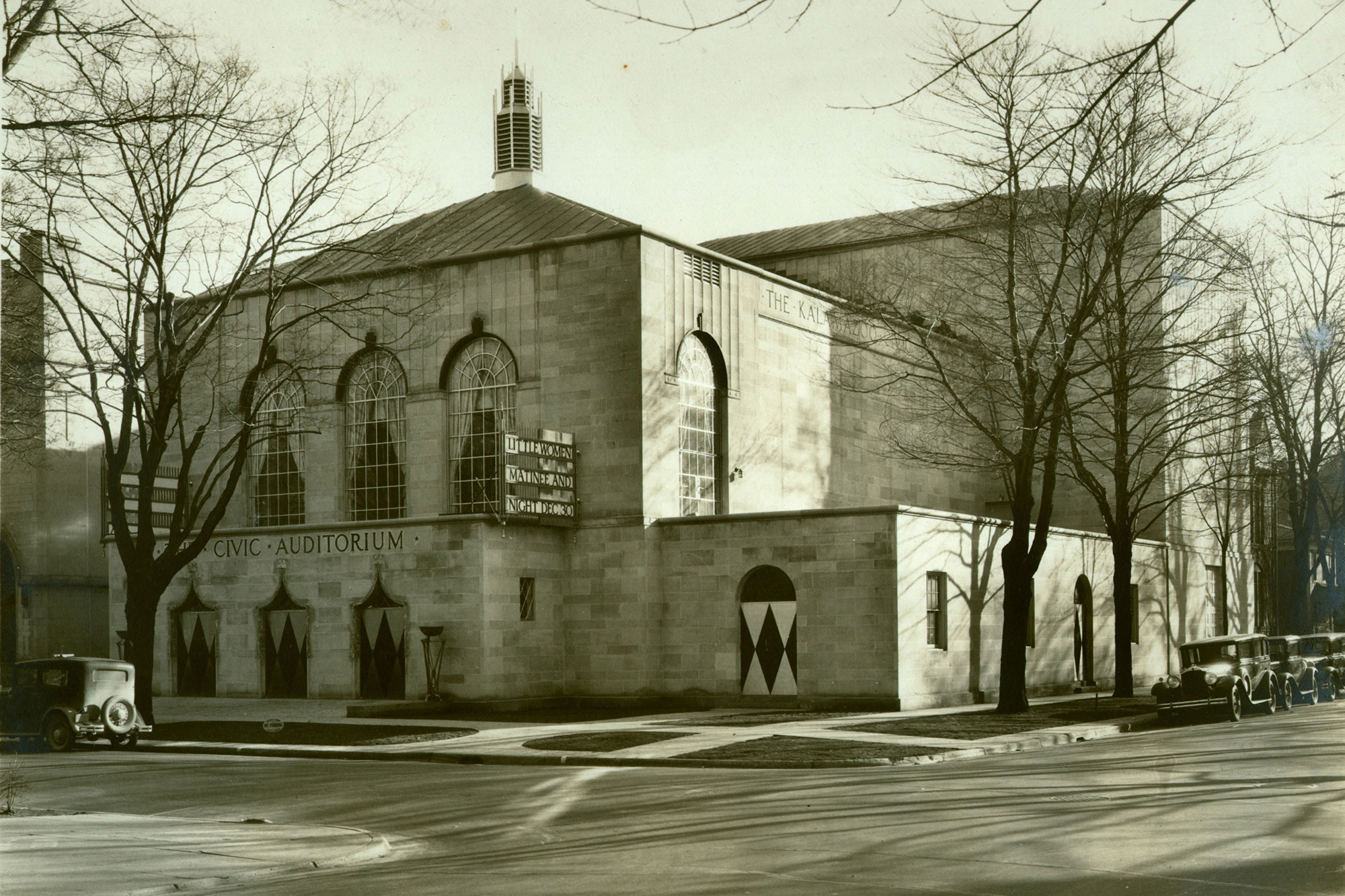About Us
From 1929 to the present, the Kalamazoo Civic Theatre has been at the forefront of community theatres in America. From its beginning, it has been praised by the public and its peers as one of the outstanding examples of just what can be done with a “Civic” or community theatre.
What started as a tiny band of people producing a few plays in Lincoln School Auditorium in the summer of 1929, has grown to be one of the premier community theatres in the country.
Founders of the theatre included Dorothy Dalton, Norman Carver Sr., Howard Chenery, Arthur Kohl, Frances Hall Kohl, Paul Fuller and Louise Carver. Their contributions to The Civic helped to set the stage for many years of high artistic quality and performance.
In its long history, the Civic has managed to survive the Depression, become a major cultural institution in southwest Michigan and is still a leader in the ranks of community theatre nationwide.
Highlights in the Civic’s History
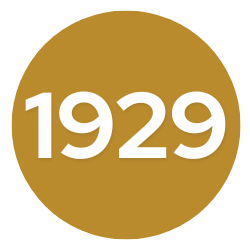 Founded by a small group of dedicated theatre enthusiasts, the Kalamazoo Civic Players presented their first season in the Lincoln School Auditorium. Founding members included Norman and Louise Carver, Howard Chenery, Arthur and Frances Hall Kohl, Dorothy Dalton and Paul Fuller.
Founded by a small group of dedicated theatre enthusiasts, the Kalamazoo Civic Players presented their first season in the Lincoln School Auditorium. Founding members included Norman and Louise Carver, Howard Chenery, Arthur and Frances Hall Kohl, Dorothy Dalton and Paul Fuller.
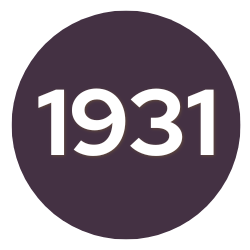 Known as the Kalamazoo Civic Players, the organization move from the Auditorium of Kalamazoo Central High School (today, Chenery Auditorium) to its permanent home at the South Street location. The theatre was state of the art for the time. Its elegant house and surrounding spaces added greatly to the performances within.
Known as the Kalamazoo Civic Players, the organization move from the Auditorium of Kalamazoo Central High School (today, Chenery Auditorium) to its permanent home at the South Street location. The theatre was state of the art for the time. Its elegant house and surrounding spaces added greatly to the performances within.
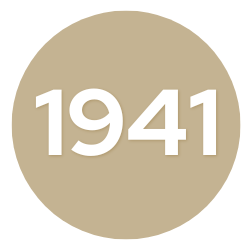 The Civic was asked by the publishers of Stage Magazine to present a production of one of their plays on Broadway. Unfortunately, performances were cancelled by World War II.
The Civic was asked by the publishers of Stage Magazine to present a production of one of their plays on Broadway. Unfortunately, performances were cancelled by World War II.
 An Intern program was created. It was the first of its kind in the nation. The first intern was Betty Ebert, who later married Jack Ragotzy. Together they founded The Barn Theatre in Augusta, Michigan.
An Intern program was created. It was the first of its kind in the nation. The first intern was Betty Ebert, who later married Jack Ragotzy. Together they founded The Barn Theatre in Augusta, Michigan.
In order to support the war effort, the Civic began touring productions to outlying communities. This outreach program was an important part of the Civic’s mission during the war years.
 The Imaginary Invalid was staged in an arena-style setting. Audience members sat on the stage, surrounding the action. This venture gave a hint of what was to come with the Carver Center.
The Imaginary Invalid was staged in an arena-style setting. Audience members sat on the stage, surrounding the action. This venture gave a hint of what was to come with the Carver Center.
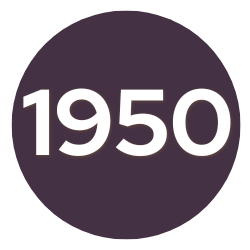 The Civic staged its 200th production The Madwoman of Chaillot.
The Civic staged its 200th production The Madwoman of Chaillot.
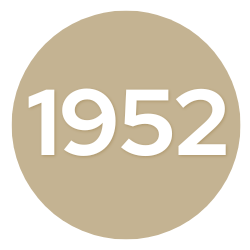 Norman Carver was elected to be the first president of the newly formed National Organization of Community Theatres, which still exists as the American Association of Community Theatres (AACT).
Norman Carver was elected to be the first president of the newly formed National Organization of Community Theatres, which still exists as the American Association of Community Theatres (AACT).
 The Civic celebrated its 25th anniversary.
The Civic celebrated its 25th anniversary.
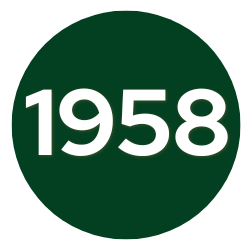 The Civic Auditorium Trustees built an annex to the Auditorium. This new facility, built one block south of the Auditorium, was needed to give the Players shop and storage space. It served as office and rehearsal space for the Kalamazoo Symphony Orchestra as well. The Trustees honored their manager of 30 years, Norman Carver, by naming the facility after him.
The Civic Auditorium Trustees built an annex to the Auditorium. This new facility, built one block south of the Auditorium, was needed to give the Players shop and storage space. It served as office and rehearsal space for the Kalamazoo Symphony Orchestra as well. The Trustees honored their manager of 30 years, Norman Carver, by naming the facility after him.
James Carver joined The Civic staff as a Production Assistant and later became Managing Director, a position he held for 23 years, until his retirement in 1997.
 The Civic was the first community theatre in the nation to present A Raisin in the Sun.
The Civic was the first community theatre in the nation to present A Raisin in the Sun.
 The Civic entered its first AACT competition. Due to an accident during the performance, they were unable to complete their performance. However, because of the quality of the performance they were given an Honorary Mention.
The Civic entered its first AACT competition. Due to an accident during the performance, they were unable to complete their performance. However, because of the quality of the performance they were given an Honorary Mention.
 The Civic forms the Civic Black Theatre
The Civic forms the Civic Black Theatre
 Fools, having won first place in State and Regional AACT/Fest competition, went on to represent The Civic at the National Festival. It was voted second place in National Competition. This Civic production represented the United States at an international theatre festival in Edinburgh, Scotland.
Fools, having won first place in State and Regional AACT/Fest competition, went on to represent The Civic at the National Festival. It was voted second place in National Competition. This Civic production represented the United States at an international theatre festival in Edinburgh, Scotland.
 The Civic presented its 500th production Our Town.
The Civic presented its 500th production Our Town.
 The Civic’s production of Dancing at Lughnasa won state and regional AACT competitions and placed 3rd in the national competition held in Midland, Texas. This outstanding production was honored for individual performances as well as production design and received an invitation to perform at the prestigious International Theatre Festival in Monaco.
The Civic’s production of Dancing at Lughnasa won state and regional AACT competitions and placed 3rd in the national competition held in Midland, Texas. This outstanding production was honored for individual performances as well as production design and received an invitation to perform at the prestigious International Theatre Festival in Monaco.
 A Capital Campaign was undertaken to fund a complete renovation of the Civic Auditorium as well as the construction of the Suzanne D. Parish Theatre. New electrical systems, rigging, stage flooring, and seating were installed in the auditorium as part of the renovation. Furnishings were reupholstered, and walls received a fresh coat of paint.
A Capital Campaign was undertaken to fund a complete renovation of the Civic Auditorium as well as the construction of the Suzanne D. Parish Theatre. New electrical systems, rigging, stage flooring, and seating were installed in the auditorium as part of the renovation. Furnishings were reupholstered, and walls received a fresh coat of paint.
 The Civic broke ground for the new Suzanne D. Parish Theatre. It was built next to the Carver Center.
The Civic broke ground for the new Suzanne D. Parish Theatre. It was built next to the Carver Center.
 The Suzanne D Parish Theatre, a multi-million-dollar state-of-the-art arena-style performance space, opened. Adjacent to the theatre was a new scenery shop and much-needed storage.
The Suzanne D Parish Theatre, a multi-million-dollar state-of-the-art arena-style performance space, opened. Adjacent to the theatre was a new scenery shop and much-needed storage.
 The Civic’s production of Forever Plaid won first place in state and regional AACT competitions and represented the region at the national competition held in Memphis, Tennessee. This production also received an invitation to the International Theatre Festival in Monaco, earning the rare honor of back-to-back invitations for the Civic.
The Civic’s production of Forever Plaid won first place in state and regional AACT competitions and represented the region at the national competition held in Memphis, Tennessee. This production also received an invitation to the International Theatre Festival in Monaco, earning the rare honor of back-to-back invitations for the Civic.
 The Kalamazoo Civic Players and the Kalamazoo Civic Auditorium merged to form the Kalamazoo Civic Theatre.
The Kalamazoo Civic Players and the Kalamazoo Civic Auditorium merged to form the Kalamazoo Civic Theatre.
 The Civic’s production of Visiting Mr. Green won first place in the state AACT competition and represented Michigan in the regional competition held in Wisconsin.
The Civic’s production of Visiting Mr. Green won first place in the state AACT competition and represented Michigan in the regional competition held in Wisconsin.
 The Civic celebrated its 75th Anniversary with a Gala Reunion Concert, which featured former volunteers that have gone on to careers in regional theatre, film, and opera as well as on Broadway and television.
The Civic celebrated its 75th Anniversary with a Gala Reunion Concert, which featured former volunteers that have gone on to careers in regional theatre, film, and opera as well as on Broadway and television.
 The Carver Center was expanded to include a new costume shop as well as rehearsal and classroom space.
The Carver Center was expanded to include a new costume shop as well as rehearsal and classroom space.
The Civic hosted the national AACT competition and theatre festival. Over 500 theatre lovers from around the world traveled to Kalamazoo to see amazing community theatre productions, attend workshops and make new friends.
The Senior Class Reader’s Theatre (SCRT) program was launched with a semi-staged production of Ladies of the Corridor. The SCRT is comprised of veteran performers (age 50 and older) who perform learned, but not memorized, lines.
 As part of the newly created Artist-in-Residence program, Broadway performers Ron Schwinn, Jerry Dixon, Peg Small and acclaimed author Alma Bond shared their skills and insights with the Civic staff, guest artists and volunteers. They also played an important role in our community outreach, teaching classes and leading group discussion.
As part of the newly created Artist-in-Residence program, Broadway performers Ron Schwinn, Jerry Dixon, Peg Small and acclaimed author Alma Bond shared their skills and insights with the Civic staff, guest artists and volunteers. They also played an important role in our community outreach, teaching classes and leading group discussion.
 The Civic was chosen as the first community theatre in the country to present a pilot production of the Tony Award-winning musical Avenue Q. A little bit naughty, and a whole lot of fun, this provocative show broke all attendance records for the Parish Theatre.
The Civic was chosen as the first community theatre in the country to present a pilot production of the Tony Award-winning musical Avenue Q. A little bit naughty, and a whole lot of fun, this provocative show broke all attendance records for the Parish Theatre.
 The Civic created the Academy of Theatre Arts. With its development, educational programming was expanded to include offerings for students as young as three years old through adulthood.
The Civic created the Academy of Theatre Arts. With its development, educational programming was expanded to include offerings for students as young as three years old through adulthood.
 The Civic hosted theaters from around the state for the Community Theatre Association of Michigan’s Annual Festival. The Civic’s production of The Imaginary Invalid was one of ten productions presented during the three-day festival.
The Civic hosted theaters from around the state for the Community Theatre Association of Michigan’s Annual Festival. The Civic’s production of The Imaginary Invalid was one of ten productions presented during the three-day festival.
 In unprecedented fashion, the Civic closed its doors to live audiences as a result of the Coronavirus Pandemic. During this time, the staff and volunteers continued to produce theatre virtually for its beloved community. Productions included The Importance of Being Ernest, Shakespeare’s The Tempest, Almost Maine and a series of short plays performed by the Civic Youth Theatre.
In unprecedented fashion, the Civic closed its doors to live audiences as a result of the Coronavirus Pandemic. During this time, the staff and volunteers continued to produce theatre virtually for its beloved community. Productions included The Importance of Being Ernest, Shakespeare’s The Tempest, Almost Maine and a series of short plays performed by the Civic Youth Theatre.
 After 622 days, the Civic reopened its doors to live audiences with The 1940’s Radio Hour in the historic Civic Auditorium.
After 622 days, the Civic reopened its doors to live audiences with The 1940’s Radio Hour in the historic Civic Auditorium.
 The Civic underwent a large strategic planning process, resulting in a new Mission, Vision and Core Values.
The Civic underwent a large strategic planning process, resulting in a new Mission, Vision and Core Values.
 The Civic welcomes Anthony J. Hamilton as Artistic Director.
The Civic welcomes Anthony J. Hamilton as Artistic Director.
